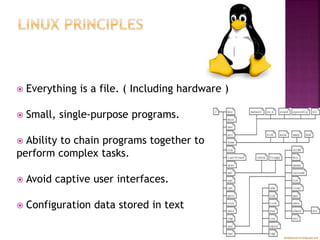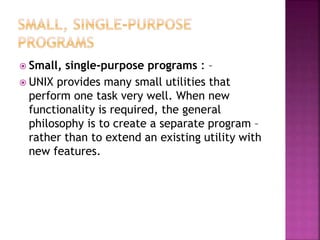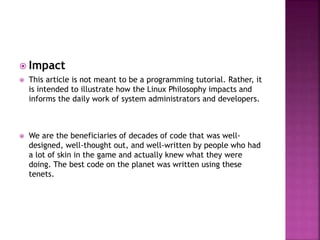Shamsa altayer
- 1. Done by: Shamsa Obaid AL Tayer 10BG
- 2. Everything is a file. ( Including hardware ) Small, single-purpose programs. Ability to chain programs together to perform complex tasks. Avoid captive user interfaces. Configuration data stored in text
- 3. Everything is a File : – UNIX systems have many powerful utilities designed to create and manipulate files. The UNIX security model is based around the security of files. By treating everything as a file, a consistency emerges. You can secure access to hardware in the same way as you secure access to a document.
- 4. Small, single-purpose programs : – UNIX provides many small utilities that perform one task very well. When new functionality is required, the general philosophy is to create a separate program – rather than to extend an existing utility with new features.
- 5. Ability to chain programs together to perform complex tasks :- A core design feature of UNIX is that the output of one program can be the input for another. This gives the user the flexibility to combine many small programs together to perform a larger, more complex task.
- 6. Avoid captive user interfaces :- Interactive commands are rare in UNIX. Most commands expect their options and arguments to be typed on the command line when the command is launched. The command completes normally, possibly producing output, or generates an error message and quits. Interactivity is reserved for programs where it makes sense, for example, text editors (of course, there are non-interactive text editors too.)
- 7. Configuration data stored in text : – Text is a universal interface, and many UNIX utilities exist to manipulate text. Storing configuration in text allows an administrator to move a configuration from one machine to another easily. There are several revision control applications that enable an administrator to track which change was made on a particular day, and provide the ability to roll back a system configuration to a particular date and time.
- 8. There are nine major tenets to the Linux philosophy. Small is Beautiful Each Program Does One Thing Well Prototype as Soon as Possible Choose Portability Over Efficiency Store Data in Flat Text Files Use Software Leverage Use Shell Scripts to Increase Leverage and Portability Avoid Captive User Interfaces Make Every Program a Filter
- 9. Make every program a filter Each of the commands that make up this command line program is a filter. That is each command will take an input, usually from Standard Input, and “filters” the data stream by making some change to it, then sends the resulting data stream to Standard Output. Standard Input and Standard Output are known collectively as STDIO. The who command generates an initial stream of data. Each following command changes that data stream in some manner, taking the Standard Input and sending the modified data to Standard Output for the next command to manipulate.
- 10. Small is beautiful and Each program does one thing well These two tenets go hand in hand. Each of the commands in this program is fairly small, and each performs a specific task. The sort command, for example does only one thing. It sorts the data stream sent to it via Standard Input and sends the results to Standard Output. It can perform numeric, alphabetic and alphanumeric sorts in forward and reverse order. But it does nothing else. It only sorts but it is very, very good at that. Because it is very small, having only 2614 lines of code as shown in the table below, it is also very fast.
- 11. Choose portability over efficiency and Use shell scripts to increase leverage and portability The portability of shell scripts can be far more efficient in the long run than the perceived efficiency of writing a program in a compiled language—not even considering the time required to compile and test such a program—because they can run on many otherwise incompatible systems.
- 12. For example, I worked on the email system at the State of North Carolina for several years. I was responsible for a collection of Perl and BASH CGI programs that ran on a Red Hat Linux host. These programs provided remote users in all of our 100 counties and hundreds of large and small agencies to perform account maintenance for their users. I was asked to test the possibility of moving all of these programs to Red Hat running on an IBM Z- series mainframe.
- 13. Use software leverage Software leverage means a couple things to me. First, and in the context of this example, it means that by using four command line commands, we are leveraging the work of the programmers who created those commands with over 7,000 lines of C code. That is code that we do not have to create. We are leveraging the efforts of those other, under-appreciated programmers to accomplish the task we have set for ourselves.
- 14. Impact This article is not meant to be a programming tutorial. Rather, it is intended to illustrate how the Linux Philosophy impacts and informs the daily work of system administrators and developers. We are the beneficiaries of decades of code that was well- designed, well-thought out, and well-written by people who had a lot of skin in the game and actually knew what they were doing. The best code on the planet was written using these tenets.
- 15. Eric Raymond: The Art of Unix Programminghttp://www.catb.org/~esr/writings /taoup/html/index.html Mike Gancarz: Linux and the Unix Philosophy; Digital Press, 2003, ISBN 1-55558-273-7 Wikipedia: http://en.wikipedia.org/wiki/Unix_p hilosophy Oregon State University:http://web.engr.oregonstate.edu/~tr aylor/ece474/lecture_verilog/beamer/linux_phil osophy.pdf














